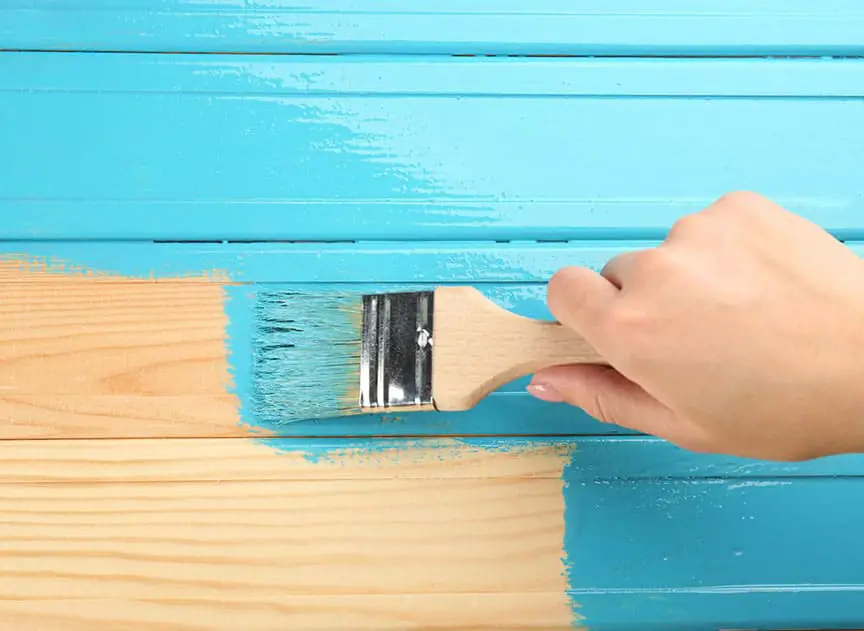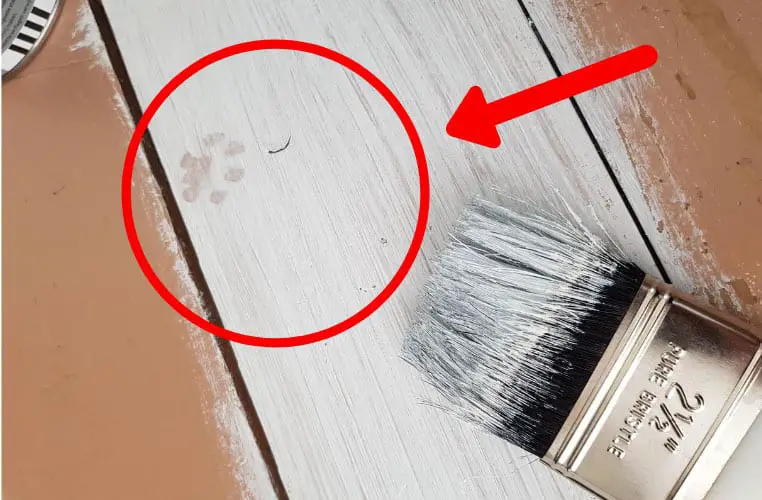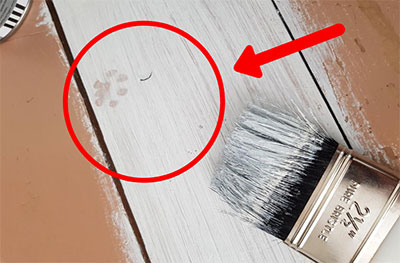I know we all have leftover paint in our sheds so I recently had to paint some wooden chairs and I had heard stories of people asking, can you use wall paint on wood? I opened a tin and I was shocked at the results I got.
Wall paint is suitable for use on wood. Oil-based and water-based paints produce the best finish on wooden surfaces. The surface will require light sand before you apply the paint with either a brush, roller, or spray.
In today’s post, I’ll explain what is in-wall paint that doesn’t make it the best choice for painting on wood in all cases. This comes from the point of view of finishing woodwork projects. We’ll also discuss more on which paints you should reach for instead and whether you want to paint your wood after cutting it or vice-versa.

What Is Wall Paint and What’s In It?
So what is wall paint anyway? Wall paint is commercial paint that’s often designed for the interior of your home. When you go to your local Home Depot or Lowe’s and pick up a can of paint, this is wall paint.
Some wall paint requires the use of a primer before applying the paint while others have the primer built-in. This is designed to save you time, as now you only have to apply a layer or two of paint versus priming the wall, letting it dry, painting, and then touching up.
If you ever flip over your bucket of paint to look at what goes into it, your wall paint will be either oil-based or water-based. Let’s discuss the two types of paint now.
Oil-Based Wall Paint
If you need to paint on an assortment of surfaces in your home, oil-based paint may be the way to go. The finish will dry rich and appealing, and this paint tends to last for a long time too. If you’re thinking of painting in a room with a lot of moisture, such as the kitchen or bathroom, oil paint is recommended.
That said, many oil-based paints contain volatile organic compounds or VOCs. When you first crack open the lid on your can of wall paint and you smell that distinct odor, that’s due to the VOCs in the paint.
When unregulated, VOCs can damage the environment and human health. These days, paint manufacturers must strictly manage the VOC content in paint, but most wall paint isn’t completely free of VOCs, oil-based paints among them.
The VOCs in oil-based paint also contribute to the very strong fumes you’ll smell when working with this type of paint. Make sure you crack open a window or have some other form of ventilation in the room while you paint. Take frequent breaks too!
Water-Based Wall Paint
Due to the downsides of oil-based paint, most wall paint you see on the shelves these days will be water-based. These paints can go without a pre-treatment, and they dry fast.
Water-based paints won’t crack, they prevent the growth of mildew, their color doesn’t become yellow over the years, and they have far fewer VOCs.
Also, given the water in this wall paint, you only need more water to clean up any messes you might accidentally make when painting.

Can Wall Paint Be Used On Wood?
Now that you understand a bit more about wall paint, let’s address the main question on your mind. That is, can you use wall paint on wood?
Wall paints can go on most wooden surfaces and are suitable, but in some instances, you might not get as clean and polished a finish. Normal wall paint will also hide the grain of the wood.
If you’re thinking of using the oil-based wall paint you have handy to coat your woodworking project, then you’re much better off going to the store and buying a paintbrush instead of using a roller.
Don’t just grab the first brush you see, either. You want a pricier, higher-quality brush.
Apply a primer before working with oil-based wall paint on wood. The high absorption qualities of wood mean it will try to absorb your oil-based paint without a primer, which can only worsen the quality of your paint job.
Avoid latex primers if you’re painting with oil-based wall paint, as the latex and oils don’t get along. Also, again, safeguard yourself and anyone else you’re painting with against the strong fumes released by oil-based paint by opening a window or several.
Can You Use Wall And Ceiling Paint On Wood?
I have used these paints on wood before and they seem to bind well. Technically you can use wall and ceiling paint on wood but there are probably better alternatives.
If I were you, I would use them in a pinch until you can find something else that is more suited to raw wood.
Which Paint Should You Use for Wood Instead?
For a safer bet regarding the quality of your woodworking project, you’re much better off with acrylic or latex paints as well as water-based paint. Here’s what you need to know about these types of wood-friendly paint.
Water-Based Paint
If you’re working with water-based paint for your woodworking project, you can skip most wood pre-treatments. This is handy, as it saves you time.
Do you wish you had oil-based wall paint instead of water-based stuff? You can always buy paint with waterborne alkyds or waterborne enamels to get the glossiness and durability of oil-based paint but with water instead.
Whether you opt for milk paint, chalk paint, or another type of water-based paint, do know that compared to oil-based paint, you don’t quite get that rich depth of color. The color will last though.
Acrylic Paint
As a water-based latex derivative, acrylic paint is like the best of both worlds from both oil-based and water-based paints. The acrylic resins within the paint give it awesome durability and noticeably bright color, and you don’t have to worry about a messy cleanup given the water in the acrylic paint formula.
You will have to prime your wood ahead of applying acrylic paint. This extra step is worth it though because the paint typically needs but a single layer to adhere to the wood. Most acrylic dries within two hours.
Then, if you want to touch it up, within four hours, you can. If you ever feel like painting masonry, metals, or plastics as part of your DIY projects, you can use acrylic paint on these surfaces as well.
The elasticity of acrylic allows it to contract and expand with the changing temperatures but without showing visible cracks. This creates a firm surface that prevents peeling and resists moisture from getting under the paint and within the wood. Like water-based paint then, acrylic paint is also fantastic at warding off mildew.
Even if your woodworking project is exposed to a lot of sun, a coat of acrylic paint won’t lose its luster or color vibrancy.
Do make sure you have a really good brush when working with acrylic paint. It lacks the flow that oil-based paint has so your brushstrokes can look obvious. You can always apply an enamel, conditioner, or another paint additive to reduce the brushstrokes if it bothers you that much.
You also want to make sure that you’re using previously unpainted wood if you’re painting it with acrylics. The bounciness of the acrylics can cause old paint to shake to the surface, ruining the look of your project.
Latex Paint
Your other option for painting a woodworking project is to use latex-based paint. This paint also features an acrylic resin. Latex is ideal for painting larger surface areas, so reserve it for your bigger wooden items like shelves or cabinets.
If you’re going for a matte finish or a satin one for your wood project, then we’d suggest using a topcoat to bring out the sheen of the latex paint. Otherwise, semi-glossy and glossy latex is smooth and shiny enough that a topcoat isn’t necessary.
Since acrylic and latex paint share some ingredients, you also have to contend with similar downsides. For example, the brushstrokes you make with latex paint will be very noticeable as well, which can drag down the appeal of your finished product.
By using latex paint products like Floetrol while you paint, you can diminish the appearance of the brushstrokes.
Should You Cut Wood Before or After Painting It?
Based on the information in this article, you’ve selected a type of wood paint for your project. With your paintbrush in hand, now you wonder if you should paint first and then cut your wood or cut first and paint after.
You always want to cut your wood first and then paint the pieces second. This is beneficial for several reasons. Using a drill or a saw near painted wood will undoubtedly leave cracks and other visible signs of damage. You’d then have to go back and do touch-ups, which wastes your valuable time.
Another convincing reason to cut and then paint is that you’re not stuck breathing in paint fumes the entire time you’re trying to chop your wood down to size.
Inhaling paint fumes for a prolonged period can cause symptoms such as nausea, dizziness, and headaches, none of which you want when you’re trying to get work done.
Conclusion – Can You Use Normal Paint On Wood?
Water-based paints are a safe bet for painting a woodworking project, especially latex and acrylic paints. You can even get away with using some wall paints if that’s all you have. Just make sure you cut your wood first and paint it afterward and you’ll be good to go!
FAQ’s
Is Acrylic An Exterior Wood Paint?
Acrylic latex paint labeled for outdoor use can be applied to exterior wood surfaces. Properly prepare the wood by cleaning, sanding, and priming, and consider using an exterior-grade clear sealer for added durability and protection against the elements.
Can You Use Wall Paint On Wooden Doors?
While it’s possible to use wall paint on wooden doors, it’s not the best choice. Wall paint isn’t formulated for the same level of durability and resistance that doors typically require.
For a longer-lasting and more robust finish on wooden doors, it’s advisable to use paints specifically designed for wood, such as acrylic or oil-based paints.
Can You Paint Straight Onto Plywood?
You can paint directly onto plywood, but it’s essential to prepare the surface correctly for the best results. Start by sanding the plywood to create a smooth and even surface, and then wipe away any dust.
Applying a coat of primer specifically designed for wood is recommended as it improves paint adhesion and enhances the paint’s durability. Once the primer is dry, you can proceed to paint your desired colors or finishes on the plywood.
Using paint designed for wood surfaces will yield the best outcome. Proper preparation and choice of paint will ensure your painted plywood looks great and lasts over time.
Can You Use Masonry Paint On Wood?
Masonry paint is not the ideal choice for painting wood surfaces. It’s specifically formulated for use on masonry, concrete, and brick surfaces, and it may not adhere well or provide the necessary flexibility on wood.




